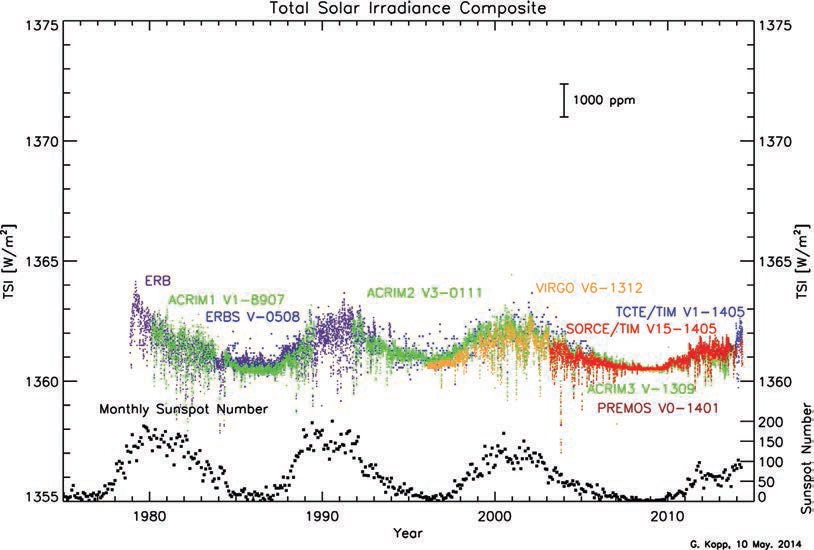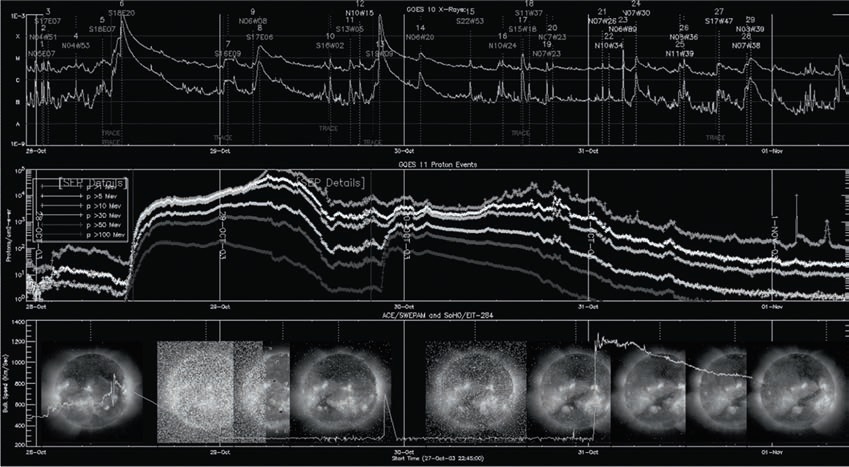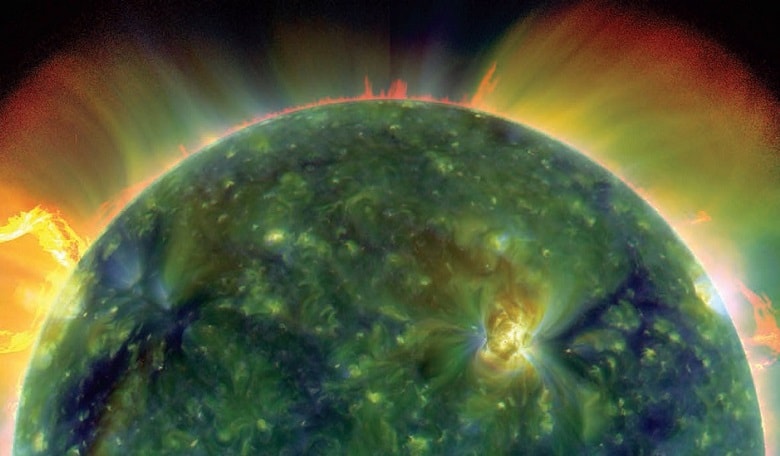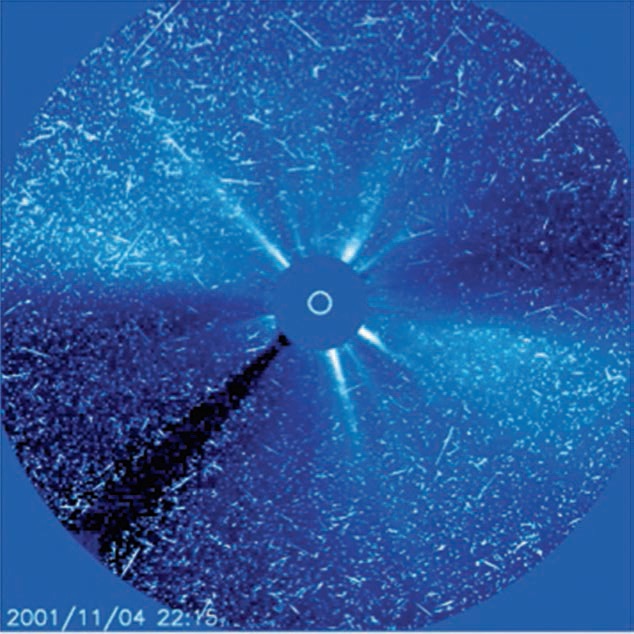The Earth is bathed in the rays of the Sun, marginally protected by a sliver of atmosphere and shielded by an invisible magnetic field. We are used to the daily migration of the Sun across the sky and its heat and light, which energise the Earth, but we seldom think about the simple fact that this is a powerful nuclear furnace on our doorstep generating vast amounts of energy and radiation, constantly buffeting our thin layers of protection. The Sun’s interaction with the Earth takes many forms but with global warming on the rise and humanity’s increasing reliance on sophisticated technology, the impact of this interaction is now more important than ever.
The Sun is a variable star exhibiting transient and cyclical behaviour on a wide variety of timescales: seconds and minutes in solar flares; hours and days in coronal mass ejections and geomagnetic storms; years and decades in sunspot production; yet centuries and millennia in its global energy generation. Some of this varied activity is predictable, some is not; but each has the ability to affect the Earth significantly, from long-term climatic impacts to short-term technological disruptions.
The relationship between the Sun and the climate of the Earth is under ever closer scrutiny as we strive to understand better all of the contributing factors affecting the dramatic increase in the warming of our planet. While it is clear that humans are responsible for much of this, understanding to what extent and how requires that we not only understand the current impact of the Sun but also its historic and future impacts.
The relationship between the Sun and Earth’s climate is under ever closer scrutiny
 The observed Total Solar Irradiance (TSI) and sunspot number count over the last 3.5 solar cycles. Measurements from different observatories have adjusted to a common scale (image courtesy of NASA and Greg Kopp)
The observed Total Solar Irradiance (TSI) and sunspot number count over the last 3.5 solar cycles. Measurements from different observatories have adjusted to a common scale (image courtesy of NASA and Greg Kopp)
Solar activity is typically defined in terms of the number of sunspots observed on the surface of the Sun. Sunspots are localised regions of strong magnetic field that emerge through the solar surface and essentially provide all of the energy for heating the solar atmosphere and driving energetic transient events like solar flares.
The solar constant
The Sun’s production of light (radiant energy) originates in nuclear fusion reactions changing hydrogen into helium in the core, some 700,000 km below the visible surface. This results in a solar luminosity of 4 x 1026 watts: the Sun produces enough energy in one second to power the United Kingdom for ten million years. The radiant energy emitted by the Sun spreads out through space so that at the distance of the Earth (150 million km) there is ~1366 W/m-2 : this is known as the solar constant. The amount that reaches the surface of the Earth depends on a number of factors, including time of day, season, latitude and cloud cover. Modern observations have shown that the solar constant is not actually constant but varies cyclically by about 0.1% over the course of the 11-year solar cycle, a periodic variation in the activity of the Sun.
From the years 1645 to 1715… the production of sunspots effectively stopped
We have continuous and detailed records of sunspot counts dating back to 1610, when telescopic solar observations became routine. Evidence of long-term solar variability exists, which provides a database going back 10,000 years, most notably in the Carbon-14 records in ancient tree rings and ice cores: high 14C means low solar activity.
Of particular note in recent times is the relative lack of visible sunspots from the years 1645-1715. For reasons that we still do not understand, the production of sunspots effectively stopped for almost 70 years (approximately seven solar cycles). This is known as the Maunder Minimum, after British astronomers Annie and Walter Maunder, who first noted it.
Meteorological records from this period indicate a major climatic impact, including longer and deeper winters in northern Europe and North America. With 400 years of observation under our belt, the last 60 involving a wide array of sophisticated solar observatories in space, we have a wealth of knowledge about this variability and its terrestrial impact. Current estimates place the solar contribution to global warming and subsequent climate change below 25 per cent.
As technology progresses, our reliance on space-based resources to go about our daily lives (telecommunications, weather monitoring, navigation, national security, entertainment, agriculture, environmental monitoring and so on) means we are increasingly susceptible to the vagaries of the changing Sun. Over the last couple of decades, solar and space physicists have coined the phrase ‘space weather’ to encapsulate the Sun’s interaction with the Earth.
The Sun’s energetic output comes in many forms – high-energy protons and electrons, UV and X-ray radiation, embedded magnetic fields – all of which have a profound impact on the Earth’s space environment. Of particular concern are the transient sudden-onset events, the solar flares and coronal mass ejections, which release huge amounts of energy in a short time, imparting much of this to the Earth’s magnetic environment and upper atmosphere.
While the number and energy content of these events generally track the observed number of sunspots, we have little ability to predict exactly when one will occur, what its magnitude will be, or what impact it will have on the Earth.
Our reliance on space-based resources… means we are increasingly susceptible to the vagaries of the changing Sun
Large space weather events can severely affect the Earth’s electronic, electrical and magnetic infrastructure in space and on the ground. The list of documented effects is long but the primary impacts include: the temporary or permanent disabling of sensitive electronics on our satellite infrastructure; compromising global communications and navigation networks; national reconnaissance; and monitoring of severe weather.
Particle and UV radiation from solar events damage the solar panels that provide the necessary spacecraft power, shortening their operational lifetimes. Enhanced magnetic activity associated with the Earth’s response to a major solar event severely affects navigational systems, thus increasing the error rate in geolocation applications affecting a wide range of industries (such as fishing, disaster management and transportation).
 Solar data from large Hallowe’en storms of 2003. Top panel shows the X-ray activity measured by the GOES satellite. Each spike represents a solar flare. Middle panel shows high-energy proton fluxes at a range of particle energies, also from the GOES satellite. Bottom panel shows extreme UV images from the SOHO/ EIT telescope with the bulk solar wind speed measured by the ACE satellite superimposed. The largest flares are associated with significantly enhanced proton fluxes (courtesy of www.lmsal.com)
Solar data from large Hallowe’en storms of 2003. Top panel shows the X-ray activity measured by the GOES satellite. Each spike represents a solar flare. Middle panel shows high-energy proton fluxes at a range of particle energies, also from the GOES satellite. Bottom panel shows extreme UV images from the SOHO/ EIT telescope with the bulk solar wind speed measured by the ACE satellite superimposed. The largest flares are associated with significantly enhanced proton fluxes (courtesy of www.lmsal.com)
On the surface, increased currents in the ionosphere can lead to ‘short circuits’ in the power grid leading to large-scale blackouts. This enhanced charging of the ionosphere also shows up in an increase of measured current levels flowing in above-ground oil and gas pipelines, leading to faster corrosion and more frequent maintenance and repair.
The enhanced radiation environment around the Earth also increases the hazard for astronauts on board the International Space Station, particularly during spacewalks, and for high-altitude aircraft crews and passengers, particularly on polar flights.
Superstorms
Over the course of an 11-year solar cycle the Sun will produce thousands of flares and coronal mass ejections (CMEs) with a wide spectrum of energies. Occasionally, however, an extremely large solar event occurs to remind us how vulnerable we are. The Carrington Flare of September 1859, the Great Storm of March 1989 and the sequence of large Hallowe’en events in October/November 2003 all resulted in major technological manifestations here on the Earth.
The Carrington Flare was the first flare ever recorded. It was so bright it was visible at optical wavelengths against the background solar disk. It also provided the first indication of an electromagnetic connection between the Sun and the Earth. One of the most important and advanced technologies of the day was the telegraph that relied on batteries to maintain a current across the wires. During the Carrington event the induced currents at ground level were so large that operators could work the telegraph with the batteries disconnected.
Increasing susceptibility
The Great Storm of 1989 resulted from a group of sunspots that ultimately spawned over 200 flares, many of the largest X classification. An intense X-class flare occurred on 6 March 1989 and was accompanied by a fast-moving CME that reached the Earth three days later. On 12 March, the Earth was bombarded by a flux of high-energy protons of 100 times normal levels. Aurora were seen as far south as Cuba, the power grid in Quebec province collapsed, and communications to several Earth-orbiting satellites were lost for several hours.
The Hallowe’en Flares of 2003 produced the most intense flare ever recorded. This series of large solar flares caused a number of major disruptions, including the fatal loss of an instrument on board the Mars Odyssey mission in orbit around the Red Planet, the loss of a Japanese satellite, the re-routing of several aircraft to more southerly latitudes, and the disruption of power in southern Sweden.
As our dependency on sensitive electronic technology grows, both in space and on the ground, we increase our susceptibility to the electromagnetic impact of solar activity.
Many government agencies list space weather as a natural hazard and factor it in to their emergency planning activities
A particle storm impacting the CCD cameras of the SOHO/LASCO telescope. Left panel shows an image from LASCO taken at 22:15 GMT on 4 November 2001. Right panel shows the same observations taken 28 hours later. The increase in high-energy particle flux is evident
This wide array of hazards associated with solar activity can have a major economic impact. As such, it merits increased awareness (coupled with resource provision) for increased monitoring and fundamental research, leading to advanced forecasting and mitigation. Many government agencies around the world list space weather as a natural hazard and factor it in to their emergency planning activities.
Last year, the White House Office of Science and Technology Policy released an assessment of the United States’ “capacity to monitor and forecast potentially harmful space weather” and the UK government unveiled a forecasting initiative for space weather to “help protect the technologies our day-to-day lives depend on”. The US Space Weather Prediction Center, based in Boulder, Colorado, provides daily space weather bulletins, alerts and forecasts utilising data from a large array of ground- and spacebased observatories.
The Sun and Earth are intimately related. The Sun’s historical and future impact on our climate are not fully understood; yet such knowledge provides a means to determine better what we must do to mitigate the coming effects of climate change.
The technological infrastructure of the Earth, on which so many facets of our 21st-century life depend, is susceptible to the energetic activity of the Sun. Much of this infrastructure operates and/or relies on resources in space, resources that operate in an extreme environment of radiation and sporadically dramatic electrical and magnetic disturbances driven by space weather.
Like weather forecasting in the 1950s, the ability to predict and forecast space weather is in its infancy and relies on our ability to understand the fundamental physics at work on the Sun, in the interplanetary medium and in the Earth’s magnetosphere.
Enhancing our understanding of this star on our doorstep will increase our ability to predict its future behaviour, enhancing our knowledge of climate change and our ability to forecast and predict the impact of solar storms at the Earth.
Further reading
The Sun, Alexander D., 2009, Series: Greenwood Guides to the Universe, Greenwood Publishing.
Storms from the Sun, Carlowicz M. and Lopez R., 2004, Joseph Henry Press, Washington, DC.
Fifth Assessment Report, Climate Change 2013: The Physical Science Basis, IPCC Working Group, 2013, Cambridge University Press, Cambridge, United Kingdom.
Solar Irradiance Variability and Climate, Solanki, S.K. Krivova, N.A. and Haigh, J.D. 2013, Annual Review of Astronomy and Astrophysics, Vol. 51: 311-51.
Space Weather Observing Systems: Current Capabilities and Requirements for the Next Decade, Report to Office of Science and Technology Policy, 2013, www.whitehouse.gov.















